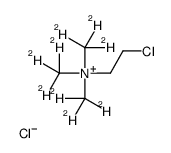Chlorocholine-d9 chloride
Modify Date: 2024-01-11 20:51:15

Chlorocholine-d9 chloride structure
|
Common Name | Chlorocholine-d9 chloride | ||
|---|---|---|---|---|
| CAS Number | 1219257-11-0 | Molecular Weight | 167.12500 | |
| Density | N/A | Boiling Point | N/A | |
| Molecular Formula | C5H4Cl2D9N | Melting Point | N/A | |
| MSDS | Chinese USA | Flash Point | N/A | |
| Symbol |

GHS07 |
Signal Word | Warning | |
Use of Chlorocholine-d9 chlorideChlorocholine-d9 (chloride) is the deuterium labeled Chlorocholine chloride[1]. Chlorocholine chloride is an effective plant growth regulator. Chlorocholine chloride can inhibit gibberellin (GA) biosynthesis. Chlorocholine chloride can be used for the research of the mechanisms and effects of GA on plant cell growth and differentiation[2][3]. |
| Name | 2-chloroethyl-tris(trideuteriomethyl)azanium,chloride |
|---|---|
| Synonym | More Synonyms |
| Description | Chlorocholine-d9 (chloride) is the deuterium labeled Chlorocholine chloride[1]. Chlorocholine chloride is an effective plant growth regulator. Chlorocholine chloride can inhibit gibberellin (GA) biosynthesis. Chlorocholine chloride can be used for the research of the mechanisms and effects of GA on plant cell growth and differentiation[2][3]. |
|---|---|
| Related Catalog | |
| In Vitro | Stable heavy isotopes of hydrogen, carbon, and other elements have been incorporated into drug molecules, largely as tracers for quantitation during the drug development process. Deuteration has gained attention because of its potential to affect the pharmacokinetic and metabolic profiles of drugs[1]. |
| References |
| Molecular Formula | C5H4Cl2D9N |
|---|---|
| Molecular Weight | 167.12500 |
| Exact Mass | 166.09900 |
| Chlorocholine Chloride-d9 |
| (2-Chloroethyl)trimethyl-d9-ammonium chloride |
| Chlorocholine chloride-(trimethyl-d9) |